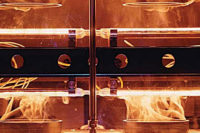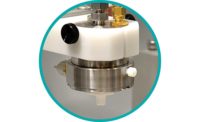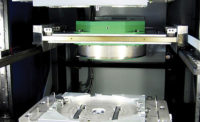For more than 30 years, manufacturers have used infrared welding (IW) to assemble plastic components that are large, made of challenging materials or have high strength and hermetic requirements. During IW, two part halves are rigidly held in position near an infrared emitting platen to melt the joining surfaces. The platen is then removed, and the part halves are squeezed together and resolidify under pressure.
About four years ago, Shanghai-based Yanfeng Automotive Interiors installed an IW machine at its Louisville, KY, facility to assemble plastic parts of the defroster grille for the Ford Escape. After a short while, however, plant management realized that it needed to do a visual check of the welded parts to verify quality. This check required a stoppage of production and involved pulling apart welded parts.
“Usually, we were taking out one to two pieces per hour as a way of sample inspection,” explains Kevin Germain, lead manufacturing engineer at the Yanfeng plant in Louisville. “Clearly this was insufficient and no guarantee for 100 percent product quality. We needed an alternative quality monitoring solution—one that does not interrupt the production flow [but does] catch possible problems before they can occur.”
Germain says four FLIR A315 thermal imaging cameras proved to be the right solution. He says Yanfeng had already experimented with a small,
handheld thermal imaging camera from FLIR, so the company knew what thermal imaging could do. The Yanfeng team purchased its cameras through Emitted Energy, a certified FLIR camera distributor and system integrator.
“Thermal imaging cameras can give an accurate temperature of the plastic parts during the welding process inside the IR welding machine,” says Roy Ray, vice president of Emitted Energy. “These cameras trigger an alarm when a temperature threshold is exceeded. By means of advanced analytics software, they can differentiate between a good and a bad weld pattern.”
Emitted Energy installed the cameras on the welding machine. Together, the cameras monitor 40 surface regions (including subsurface defects and anomalies) on the plastic parts after the heat cycle.
If the part temperature falls within the upper and lower control limits, built-in analysis software sends a pass signal to the machine PLC and the welding process is continued. If not, the software sends a fail signal to the PLC, which stops the welding process. An operator then removes the rejected part, does a visual check and restarts the operation.
The software enables Yanfeng to map out heat trends over time and combine that information with additional data (such as squeeze pressure and IR heater voltage power) generated by other sensors. Most importantly, it ensures that all IW welds are high quality, error-free and repeatable.
“The cameras allow us to monitor weld quality without interrupting the welding process—even when nobody is attending the welding machine,” says Germain. “Since we no longer have to take apart the welded components, we have also significantly reduced the scrap rate.”
For more information on thermal imaging cameras, call 844-283-5471 or visit www.flir.com.





